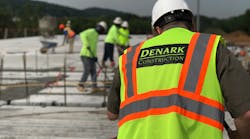Most of the work done on construction projects undertaken by Denark Construction Inc. is performed by subcontractors. Denark prides itself on providing every person a safe working environment, and subcontractors are no exception.
"There have been situations where employees of a subcontractor were not performing their work safely, and we needed to intervene," explains Grant Rosenberg, vice president of Denark. He cites as an example a recent project where a group of masons were on a scaffold that was not erected to OSHA standards, and as a result the workers were at risk of falls of more than 20 feet, causing Denark to halt work immediately.
"Our safety manager and superintendent determined there had not been effective training; therefore, we scheduled a two-hour scaffold call the next morning," he remembers. "Work resumed and the results were very successful."
It's part of the company's policy of encouraging and empowering all team members to prevent accidents on Denark projects. "Rather than sending subcontractors off the job to become another general contractor's safety concern, we believe we should do whatever it takes to educate all workers to be safe in their jobs." This training, by the way, is provided at no cost to the subcontractor.
In 2017, Denark had a lost-time injury rate of 0, which compares very favorably against an industry average rate of 1.2. Thanks to its implementation of a strong safety process for tracking injuries, Denark is able to identify patterns of bad habits or lack of education that need to be addressed. Each project maintains a first report of injury for all subcontractor employees on site, Rosenberg points out.
Denark's occupational safety and health program focuses on five key areas, he explains: people, planning, communication, analysis and execution.
Every day, Denark's superintendent identifies any potentially unsafe working conditions and immediately acts on corrective measures. Also, Denark's safety manager conducts regular site inspections to ensure that workers are abiding by procedures and that the site is safe.
"By involving everyone early in the safety process, we establish trust," Rosenberg points out. "This trust results in a relationship based on shared expectations that we hold ourselves accountable to. Over time, our consistent application of this relatively simple philosophy has led to a safety-oriented culture."


